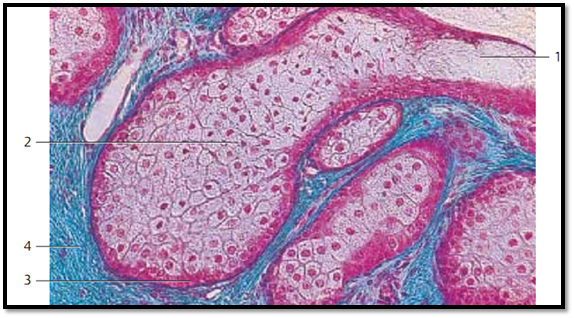


 النبات
النبات
 الحيوان
الحيوان
 الأحياء المجهرية
الأحياء المجهرية
 علم الأمراض
علم الأمراض
 التقانة الإحيائية
التقانة الإحيائية
 التقنية الحيوية المكروبية
التقنية الحيوية المكروبية
 التقنية الحياتية النانوية
التقنية الحياتية النانوية
 علم الأجنة
علم الأجنة
 الأحياء الجزيئي
الأحياء الجزيئي
 علم وظائف الأعضاء
علم وظائف الأعضاء
 الغدد
الغدد
 المضادات الحيوية
المضادات الحيوية|
Read More
Date: 14-8-2016
Date: 17-1-2017
Date: 27-7-2016
|
Extraepithelial Glands-Holocrine Sebaceous Glands
Sebaceous glands consist of bulbous multilayered epithelium cones, termed sebaceous bulbs or sacs, which lack a luminal space. The neck of the main bulb opens to the hair shaft. The cells inside the bulb grow larger, produce sebum and consequently, change into sebum cells 2 . Their nuclei then die ( apoptosis). In the usual preparations use d for teaching purposes, the fat droplets are removed. This leads to more and more vacuoles in the cells at the center. While producing the secretory product , the cells die and are extrude d together with the secretory material (sebum): holocrine extrusion, holocytosis, (cell lysis). New cells arrive from a supply line, which start at the peripheral cell layer (substitute cells, basal cells) 3 .
1 Sebum in the neck of the gland
2 Sebaceous gland cells
3 Peripheral cells (substitute cells, basal cells)
4 Dense regular connective tissue
Stain: azan; magnification: × 65

References
Kuehnel, W.(2003). Color Atlas of Cytology, Histology, and Microscopic Anatomy. 4th edition . Institute of Anatomy Universitätzu Luebeck Luebeck, Germany . Thieme Stuttgar t · New York .



|
|
|
|
"عادة ليلية" قد تكون المفتاح للوقاية من الخرف
|
|
|
|
|
|
|
ممتص الصدمات: طريقة عمله وأهميته وأبرز علامات تلفه
|
|
|
|
|
|
|
المجمع العلمي للقرآن الكريم يقيم جلسة حوارية لطلبة جامعة الكوفة
|
|
|